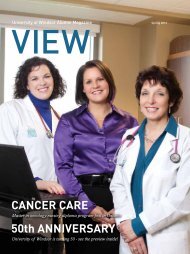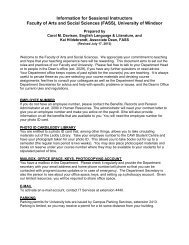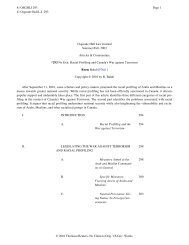Bevis Made Easy - University of Windsor
Bevis Made Easy - University of Windsor
Bevis Made Easy - University of Windsor
Create successful ePaper yourself
Turn your PDF publications into a flip-book with our unique Google optimized e-Paper software.
<strong>Bevis</strong> <strong>Made</strong> <strong>Easy</strong>: A Humanistic Existentialism Philosophy<br />
First Compiled by Dr. D. Foley, 2003<br />
Updated, adapted, and revised by Dr. S. McMahon, 2009<br />
Summarized by Veronica Voakes and Christina Raheb, 2009<br />
<strong>Bevis</strong> Curriculum Process<br />
The process and key concepts from Dr.Em Olivia <strong>Bevis</strong>’ Curriculum Building<br />
Framework (1973, 1982, and 1989) have been adopted by the <strong>University</strong> <strong>of</strong> <strong>Windsor</strong>, and<br />
St.Clair and Lambton Colleges. Additional resources can be found at<br />
www.uwindsor.ca/nursing on the link “<strong>Bevis</strong> Comes Alive”.<br />
Adaptation<br />
- A process. Interaction <strong>of</strong> variables with the dynamics <strong>of</strong> stress and strain.<br />
Advocacy<br />
- for self and others may be expressed and demonstrated when the principles <strong>of</strong><br />
social justice are applied to situations <strong>of</strong> oppression, marginalization, and<br />
victimization.<br />
Bonadaptation.<br />
- Eustress, healthy response.<br />
Caring<br />
- Four Stages <strong>of</strong> Caring were espoused namely: Attachment, Assiduity, Intimacy,<br />
and Confirmation (<strong>Bevis</strong>, 1989, p. 128). “transactional relationship”.<br />
1) Attachment- with phases <strong>of</strong>: recognition- acknowledgement,<br />
self-revelation (step1; data gathering) validation, potency<br />
2) Assiduity- with phases <strong>of</strong>: respect, potentiality, attentiveness, honesty, selfrevelation<br />
( step 2; individual’s sense <strong>of</strong> self, values, fears, affirmation <strong>of</strong><br />
meaning , responsibility, confidence, courage<br />
3) Intimacy- with phases <strong>of</strong>: probity, self-reflection(step3; personal vulnerabilities,<br />
secrets, covert experiences, self-doubts, shame/guilt. revelation <strong>of</strong> intimate<br />
depth and honesty, confession ), perspicacity, sexuality, inclusiveness<br />
4) Confirmation- with phases <strong>of</strong>: personal validation, augmentation, sustainmentempowerment,<br />
expansiveness<br />
- Caring is a process, a state, an attitude, a strategy, an enabling factor, as well as a<br />
tool.<br />
Common and Distinct Manifestations <strong>of</strong> Episodic and Chronic/Long-term<br />
Conditions<br />
- Organizational strategies to manage and sort data into Common and Distinct<br />
- Manifestations <strong>of</strong> holistic health states such as:<br />
1. Signs and symptoms <strong>of</strong> health and illness<br />
2. Life Processes and Sub Processes<br />
3. System responses such as excesses (hyper) and insufficiencies (hypo)<br />
manifestations.<br />
- These were all viewed as variations from the desired centre-balance or homeostasis<br />
position, and normative state. Homeostasis and Norms are the desired outcomes.
1. The Person as the individual client (intrapersonal system & interpersonal<br />
system)<br />
2. Family as client (interpersonal system)<br />
3. The Group – loosely connected individuals who share a task or goal focus<br />
(temporary or long term)<br />
4. Community (or population level <strong>of</strong> affiliation) – identifiable groups clustered in<br />
similar places, for identified purposes and <strong>of</strong> clusters <strong>of</strong> groups, families, and individuals<br />
referred to as the community system<br />
5. Populations – collective communities and identified by common<br />
characteristics, environment, target health risk threat, need or resource.<br />
Communication<br />
- a process, a skill, a core competency, a strategy, and an enabling factor that will<br />
enhance the quality and efficacy <strong>of</strong> the nursing process and all other nursing<br />
interventions.<br />
Community System<br />
- The target <strong>of</strong> nursing behaviors that facilitate optimal functioning <strong>of</strong> a “group <strong>of</strong><br />
people having common organization and mutual interest”. Nurses with in<br />
numerous communities. Any activity the nurses engages in to promote<br />
community coping or maturation qualifies as a community activity (<strong>Bevis</strong>, 1982,<br />
p.19).<br />
Critical Thinking<br />
- Through a higher level <strong>of</strong> thought, the human is able to create elements <strong>of</strong> logic,<br />
and explore the benefits and consequences <strong>of</strong> actions. Critical thinking progresses<br />
from simple to complex levels in purposeful ways.<br />
Creativity<br />
- A unique plan designed to help individualized collective client systems find<br />
meaning in experiences to foster adaptation and maturation.<br />
Decision-making<br />
- Decision making is the acquiring, ordering, and selecting <strong>of</strong> tools, resources,<br />
or alternatives for reaching goals or fulfilling needs.<br />
Empowerment for Self-responsibility and Advocacy<br />
- This is a process whereby individuals become active in their healthcare by<br />
directing their own resources, processes, personnel, and tools within their<br />
environment so that they may achieve optimal health, wellness, and wellbeing.<br />
Enabling Factors<br />
- Enabling factors within a system are features that assist with the operation and<br />
flow <strong>of</strong> the system and enhance the efficacy <strong>of</strong> the outcomes.<br />
- Enabling Factors for the Collaborative <strong>Bevis</strong> Nursing System for Education<br />
and Practice are: Caring Communication Creativity Critical thinking Cultural<br />
sensitivity Ethics Economics Empowerment Health, well-being, and safety<br />
Healthcare technology Influence Optimal quality standards Pr<strong>of</strong>essionalism<br />
Research Reflection<br />
Environment<br />
- An environment may be internal and physiological or external involving an<br />
individual’s immediate surroundings including all that is living, and non-
living. Plans and actions for human survival, optimal holistic health and wellbeing<br />
must be considered in any nursing care plan for the client system.<br />
Existentialism<br />
- Each person is unique, the whole <strong>of</strong> a human being is different from his/her<br />
parts, and humans are thinking beings that can make choices.<br />
- A human is free and possesses freedom to choose but they are accountable to<br />
themselves and other human beings.<br />
Generative Behaviors<br />
- nursing measures that are innovative, productive, reproductive, and/or<br />
rehabilitative. These are included in tertiary care components.<br />
Generative Interventions (G)<br />
- Identify dangerous and unhealthy variables in the environment that may cause<br />
harm, distress, and discomfort, which threaten recovery or rehabilitation.<br />
Interventions are focused on the removal <strong>of</strong> these unhealthy and noxious<br />
factors and the development <strong>of</strong> role adjustment during aspects <strong>of</strong> crises,<br />
distress, strain, malfunctioning, lack <strong>of</strong> information or uncoordinated resource<br />
allocation and availability.<br />
Health<br />
- Health is a resource for everyday life. It is the goal <strong>of</strong> all nursing behaviors.<br />
Culture, life choices, resources, power, place and time, as well as many other<br />
variables can influence health. Health can be enhanced by the utilization <strong>of</strong><br />
enabling factors. Health is a dynamic process where the individual, family, or<br />
community is able to realize aspirations, satisfy needs, and change or cope<br />
with the environment.<br />
Humanism<br />
- Emphasizes value, beauty, and importance in being human and is concerned<br />
with human existence and quality <strong>of</strong> life.<br />
Interpersonal<br />
- The target <strong>of</strong> nursing behaviors that promote optimal functioning <strong>of</strong> groups,<br />
families, and communities.<br />
Intrapersonal<br />
- The target <strong>of</strong> nursing behaviors. (Within a personal space).<br />
Leadership/Management/Planned Change<br />
- The process <strong>of</strong> leadership/management/planned change subsumes the<br />
processes <strong>of</strong> leadership, organizational structure, and management. Planned<br />
change is the purposeful planned adaptation to a shift in the environment<br />
Learning<br />
- A change in behaviour, perception, insights, attitude, or a combination <strong>of</strong><br />
these that can be repeated when the need is aroused, is considered to be<br />
learning.<br />
Lifestyles<br />
- are the choices that client systems make in regard to health options, practices,<br />
beliefs, cues and behaviours.<br />
Lifespaces<br />
- refer to the environments or where the client system conducts their life styles<br />
and life ways
Lifeways<br />
- strategies, actions, behaviours, and methods that client systems use to achieve<br />
the health goals.<br />
Maladaptation<br />
- a matter <strong>of</strong> perception, not the intent <strong>of</strong> the systemic response<br />
Nursing<br />
- Nursing is a process with a purpose <strong>of</strong> promoting optimal health and wellbeing<br />
<strong>of</strong> individuals, families, groups, and communities. Nursing’s role is to<br />
facilitate life processes and subprocesses in the client system. Nurses are<br />
regulated health pr<strong>of</strong>essionals who provide care with the purpose <strong>of</strong><br />
promoting “the highest possible level <strong>of</strong> health or self actualization for<br />
clients/patients” (<strong>Bevis</strong>, 1982, p.16-17).<br />
Nursing Process<br />
- The phases <strong>of</strong> the Nursing Process are: Assessment, Diagnosis, Prioritization,<br />
Planning, Implementation, and Evaluation. These phases are spread across the<br />
3 stages <strong>of</strong> the client system (Input, Throughout, and Output.) with feedback<br />
and reassessments expected continuously.<br />
Nurtrative Behaviors<br />
- nursing measures that are therapeutic, curative, comforting, and supportive.<br />
(Secondary care)<br />
Nurtrative Interventions (N)<br />
- Designed to be helpful, facilitate change, and encourage ongoing observations<br />
and activities to foster homeostasis, adaptation and maturation, comfort care,<br />
and healing interventions which would promote recovery and recuperation.<br />
This is referred to a secondary prevention. It is focused on limiting injury and<br />
illness.<br />
Person<br />
- Individuals are unique, holistic persons who experience the world through<br />
their own lived experiences. Individuals seek to understand who they are, their<br />
purpose, and their place across the dimensions <strong>of</strong> time and space. They are<br />
worthy <strong>of</strong> respect and care, are responsible beings capable <strong>of</strong> entering<br />
relationships that foster maturation and self-actualization<br />
Philosophical Foundation<br />
- Provides insight into beliefs about persons, environment, health, and nursing<br />
while simultaneously influencing values, attitudes, choices, and behaviors.<br />
Population System<br />
- Collections <strong>of</strong> communities or groups with identifiable indicators that form a<br />
significant target for concern for nursing behaviors to be applied. This may<br />
occur on a global scale (e.g. with disaster planning).<br />
Problem-solving<br />
- a dynamic, orderly process and is used to arrive at a place where decisions can<br />
be made.<br />
Protective Behaviors<br />
- prevent disease or diminishing health; maintain and promote health. (Primary<br />
care)
Protective Interventions (P)<br />
- Focused prevention, safety, well-being, optimal health, primary health, and<br />
adaptation focused activities. These are referred to as primary prevention.<br />
Purpose<br />
- Through preventative (protective), therapeutic (nurtrative), and rehabilitative<br />
(generative) nursing behaviors, and in collaboration with individuals, families,<br />
groups, and communities, nurses strive to achieve, maintain or restore health.<br />
Health or a high level <strong>of</strong> wellness is central to the whole system and is the<br />
purpose <strong>of</strong> the nursing process<br />
Research<br />
- an orderly process <strong>of</strong> problem examination, inquiry, exploration, and<br />
validation that will assist systems to explore and examine phenomena and<br />
unknown questions related to client systems (<strong>of</strong> all kinds).<br />
Strain<br />
- human response to stimuli that attempts to foster health adaptation and<br />
promotes coping to individual stress stimuli or clusters <strong>of</strong> stressors.<br />
Stress<br />
- refers to those forces or stimuli that press in upon or stimulate a system.<br />
Subprocesses<br />
- contribute to the flow and context <strong>of</strong> the Life Processes.<br />
1. Stress/Strain<br />
2. Critical thinking<br />
3. Communication<br />
4. Learning<br />
5. Human growth and development needs and maturation<br />
6. Change/Leadership<br />
7. Self-responsibility<br />
8. Caring<br />
9. Lifeways and lifestyling elements (stress control/change, physical<br />
fitness/exercise, nutrition/diet/healthy weights, self-responsibility for healthy life choices<br />
etc.) and lifespaces.<br />
Teaching<br />
- purposeful activity designed to facilitate learning and hence, becomes linked<br />
to learning. Teaching is a process <strong>of</strong> creating an environment where learning<br />
can take place.<br />
Theoretical Basis: System and Process<br />
General Systems Theory<br />
- A system functions as a unit with separate parts that can stand alone or be<br />
organized in an interdependent fashion to create a sense <strong>of</strong> “oneness”.<br />
- The system is never static and “being” is never the same over time<br />
- The major focus is on the person as a system.<br />
- Individuals are open systems. Systems have inputs (energy and information<br />
going into the system), throughputs (processes and interactions), and outputs<br />
(energy and information going out <strong>of</strong> the system).<br />
- Nurses function within the state <strong>of</strong> the client system by applying the Nursing<br />
process to gain an understanding <strong>of</strong> their needs, goals, life processes and
subprocesses. They then plan tools and strategies to implement to facilitate<br />
desired outcomes for client systems.<br />
Table 1<br />
Life Processes Subprocesses Nursing Tools and Strategies<br />
Maturation Stress/Strain Caring<br />
Adaptation Change Communication<br />
- Critical thinking Teaching<br />
- Communication Problem Solving<br />
- Learning Decision making<br />
- Growth and development Leadership/Management<br />
- Management, leadership Planned change<br />
Caring<br />
Self responsibility, lifestyle<br />
Research<br />
Empowerment for self<br />
responsibility and advocacy<br />
Organization <strong>of</strong> General Systems Theory<br />
Input Throughput Output<br />
Input<br />
- Derived from assessment data and information concerning the needs, goals,<br />
problem, and desire <strong>of</strong> the client system.<br />
Table 2<br />
Throughput<br />
Theories<br />
Processes<br />
Concepts<br />
Constructs<br />
Paradigms<br />
Nursing knowledge and information<br />
From science and the arts (related to humanity)<br />
Synthesized into useful content to<br />
inform nursing measures, thought,<br />
action, effect, decision making, life<br />
processes and subprocesses,<br />
nursing strategies and tools.<br />
(See Table 1)<br />
Output - The nursing behaviors or actions, skills, roles, services, and functions <strong>of</strong><br />
nursing comprise the output <strong>of</strong> the system and result from the synthesis <strong>of</strong> the throughput<br />
component. Output :All output fosters the life processes.<br />
Tools and Strategies for Nursing Practice<br />
1. Caring<br />
2. Communication<br />
3. Teaching<br />
4. Problem-solving/Decision-making<br />
5. Leadership/Management/Planned change<br />
6. Research<br />
7. Empowerment for Self-responsibility and Advocacy





